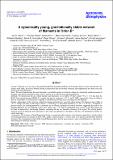Por favor, use este identificador para citar o enlazar a este item:
http://hdl.handle.net/10261/202696COMPARTIR / EXPORTAR:
 SHARE SHARE
 CORE
BASE CORE
BASE
|
|
| Visualizar otros formatos: MARC | Dublin Core | RDF | ORE | MODS | METS | DIDL | DATACITE | |

| Título: | A dynamically young, gravitationally stable network of filaments in Orion B |
Autor: | Orkisz, J. H.; Peretto, Nicolas; Pety, Jérôme; Gerin, Maryvonne; Levrier, F.; Bron, Emeric CSIC ORCID; Bardeau, Sébastien; Goicoechea, Javier R. CSIC ORCID; Gratier, Pierre; Guzmán, Viviana V.; Hughes, A.; Languignon, David; Le Petit, F.; Liszt, H. S.; Öberg, Karin; Roueff, Evelyne; Sievers, Albrech; Tremblin, Pascal | Palabras clave: | ISM: clouds ISM: structure ISM: kinematics and dynamics Methods: data analysis Radio lines: ISM ISM: individual objects: Orion B |
Fecha de publicación: | 22-abr-2019 | Editor: | Springer Nature | Citación: | Astronomy and Astrophysics 624: A113 (2019) | Resumen: | Context. Filaments are a key step on the path that leads from molecular clouds to star formation. However, their characteristics, for
instance their width, are heavily debated and the exact processes that lead to their formation and fragmentation into dense cores still
remain to be fully understood.
Aims. We aim at characterising the mass, kinematics, and stability against gravitational collapse of a statistically significant sample of
filaments in the Orion B molecular cloud, which is renown for its very low star formation efficiency.
Methods. We characterised the gas column densities and kinematics over a field of 1.9 deg2
, using C18O (J = 1−0) data from the
IRAM 30 m large programme ORION-B at angular and spectral resolutions of 23.5
00 and 49.5 kHz, respectively. Using two different
Hessian-based filters, we extracted and compared two filamentary networks, each containing over 100 filaments.
Results. Independent of the extraction method, the filament networks have consistent characteristics. The filaments have widths of
∼0.12 ± 0.04 pc and show a wide range of linear (∼1−100 M pc−1
) and volume densities (∼2 × 103−2 × 105
cm−3
). Compared to
previous studies, the filament population is dominated by low-density, thermally sub-critical structures, suggesting that most of the
identified filaments are not collapsing to form stars. In fact, only ∼1% of the Orion B cloud mass covered by our observations can
be found in super-critical, star-forming filaments, explaining the low star formation efficiency of the region. The velocity profiles
observed across the filaments show quiescence in the centre and coherency in the plane of the sky, even though these profiles are
mostly supersonic.
Conclusions. The filaments in Orion B apparently belong to a continuum which contains a few elements comparable to already studied
star-forming filaments, for example in the IC 5146, Aquila or Taurus regions, as well as many lower density, gravitationally unbound
structures. This comprehensive study of the Orion B filaments shows that the mass fraction in super-critical filaments is a key factor in
determining star formation efficiency. 22 pags., 15 figs., 4 tabs., 2 apps. |
Versión del editor: | http://dx.doi.org/10.1051/0004-6361/201833410 | URI: | http://hdl.handle.net/10261/202696 | DOI: | 10.1051/0004-6361/201833410 | Identificadores: | doi: 10.1051/0004-6361/201833410 issn: 1432-0746 |
| Aparece en las colecciones: | (CFMAC-IFF) Artículos |
Ficheros en este ítem:
| Fichero | Descripción | Tamaño | Formato | |
|---|---|---|---|---|
| A dynamically young.pdf | 4,08 MB | Adobe PDF |  Visualizar/Abrir |
CORE Recommender
SCOPUSTM
Citations
24
checked on 11-abr-2024
WEB OF SCIENCETM
Citations
23
checked on 26-feb-2024
Page view(s)
178
checked on 18-abr-2024
Download(s)
100
checked on 18-abr-2024
Google ScholarTM
Check
Altmetric
Altmetric
NOTA: Los ítems de Digital.CSIC están protegidos por copyright, con todos los derechos reservados, a menos que se indique lo contrario.
